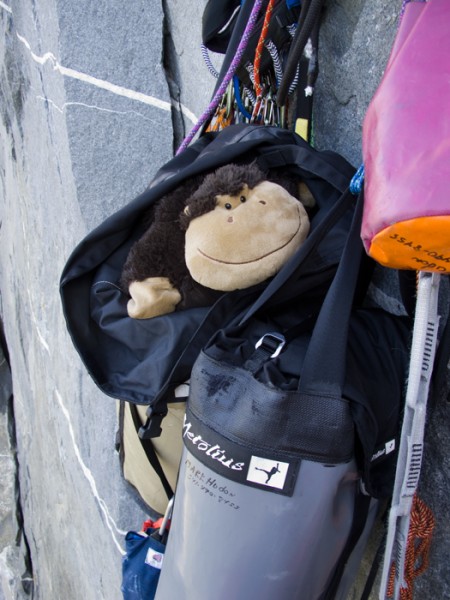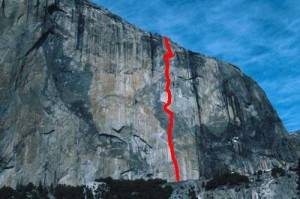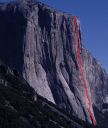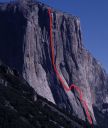So here ya go...
“Okay, no emotion, no agony, no discussion, black or white, yes or no, done deal, can I have eight more days to solo Zenyatta Mondatta’? I asked my wife, Peggy, over the phone.
The trip wasn’t going well, the weather was bad, continuously cold and rainy, and we had already bailed from Zenyatta Mondatta when John told me that he was in over his head and couldn’t do it. I’ve bailed on enough El Cap routes and it will probably be sooner rather than later that I won’t even be able to do them anymore. I don’t have the time left to fail on any more El Cap routes.
I had thoroughly enjoyed the first four pitches of ZM. None of the climbing was obvious, the route wandered all over the place, was interesting and challenging. Challenging if you don’t mind top stepping off your fifth hook in a row to place a beak or tiny nut. My game was to climb the route as cleanly as I could and avoid using any copperheads, fixed or not. I was having a great time, although the weather wasn’t adding to our enjoyment, it was cold and every now and then the water dripping off the roofs near the top of the Zodiac would bomb us. Probably the recent story of a climber taking fifty footer onto the anchor on the fourth pitch didn’t help, that was John’s pitch.

Visit on gorge.net
Cathedral Rocks in the clouds
“Yes”, Peggy said, I looked at John and told him he would have to find a way home.
With John’s help, I made a few trips back up to the base of the route, bringing up the gear and water I’d need. I hadn’t thought for a minute of soloing the route before leaving Hood River so I had to buy a few things at the Mountain Shop, some cords, a fifi hook and some slings. I didn’t want to suffer too badly humping loads so I went up one day, fixed a pitch and hauled a bit of stuff to it’s top.
I never thought too much what it would be like to solo ZM, I just though, yeah, I’ve soloed El Cap before, it’s a lot of work but it’s fun.
I was excited about trying to climb the route clean and additionally, I wanted to try to climb it clean-clean as much as possible, avoiding anything fixed aside from rivets and bolts. I had the whole SuperTopo pin rack but I knew that if I used it the route would be mainly A2+ with a little bit of A3 thrown in. Whaling in pins and clipping fixed copperheads was not my idea of fun, adventure or challenge. On the first pitch I easily climbed past seven or eight copperheads, most of which were placed in ridiculous spots, in A1 cracks or right next to obvious and bomber hook or nut placements.
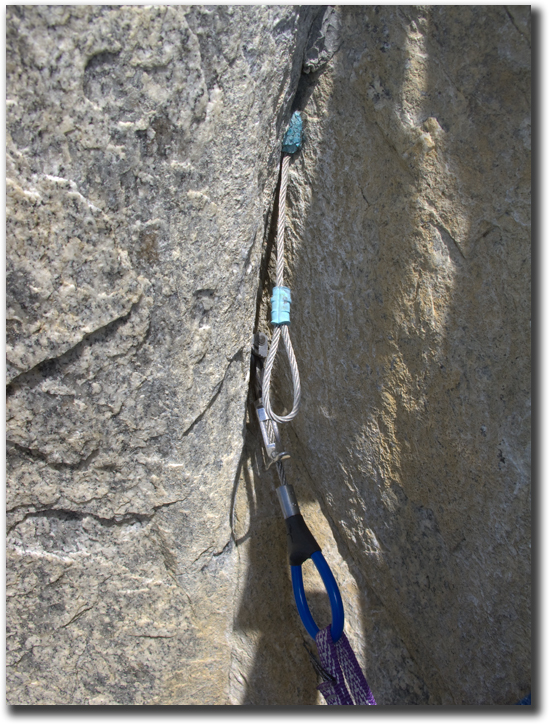
Visit on gorge.net
Hmmm... a head worth about 300 pounds or a cam worth about a gazillion?
Some of these I took out while leading and others while cleaning. All in all, I used only two fixed copperheads on the whole pitch. I hauled a bit of gear, fixed a rope and descended. Later that day John and I carried the last bit of gear up to the base. I was ready to blast and psyched to go. The next morning I dropped John off at the Curry bus station and drove to El Cap. It was pretty nice hiking to the base for the first time with no pack whatsoever. It was a casual stroll under the most beautiful cliff in the world. The air was cool, the sky was crazy clear and I was heading towards 8 days of soloing on El Cap. Life doesn’t get much better.

Visit on gorge.net
Looking up El Cap, the most beautiful cliff in the world.
Earlier, I had had a little incident with bears at the base, although I thought I had placed my gear on top of a rock inaccessible to any bear, it wasn’t, and they had shredded a bag I had previously used for wall garbage, ripping the collar off my ledge bag in the process.
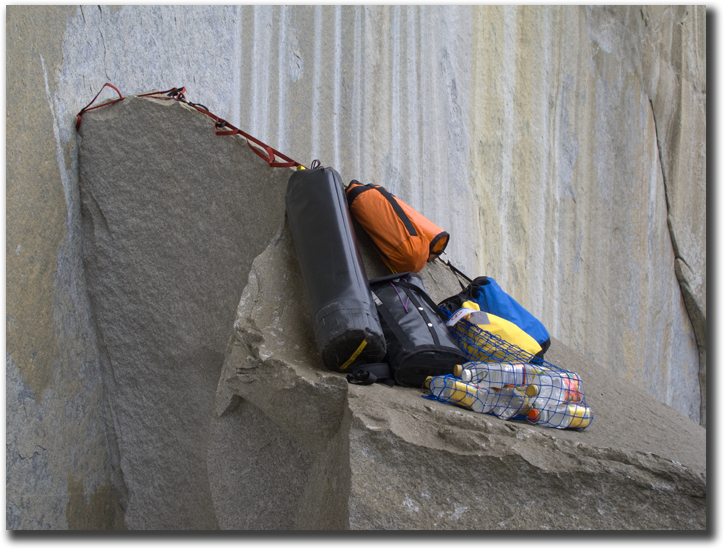
Visit on gorge.net
Somehow the bears got to the bags.
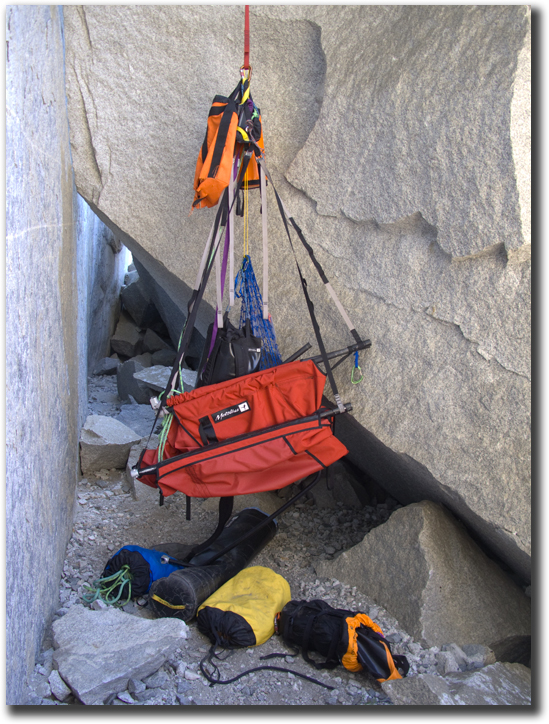
Visit on gorge.net
Luckily, not much damage.
I fixed the ledge bag but all my stuff was hanging high off my haul line and on top of nearby rock. I got it all down, packed the pigs, a Metolius Half Dome and a Quarter Dome, far less than I had on my first El Cap solo last year. Upon arriving at the top of my first rope and starting to haul I found that hauling with my traditional 2 to1 was ridiculously easy but when I changed to 1 to 1 it took a bit more effort than I was willing to give. My approach to big wall soloing is to conserve strength at all costs. It’s a simple fact that the older you get, the longer it takes to recover from hard exertion. Also, given the fact that you can’t haul enough calories to replenish the calories you burn on a wall there is a finite time you can spend soloing before you run out of strength. I had asked for 8 more days to solo the route, figuring that it is 16 pitches long and that I could probably climb two pitches a day. In early June, with the longest day of the year just around the corner, I figured I’d have enough time to climb two pitches, set up and take down camp and lay around and enjoy being on El Cap.
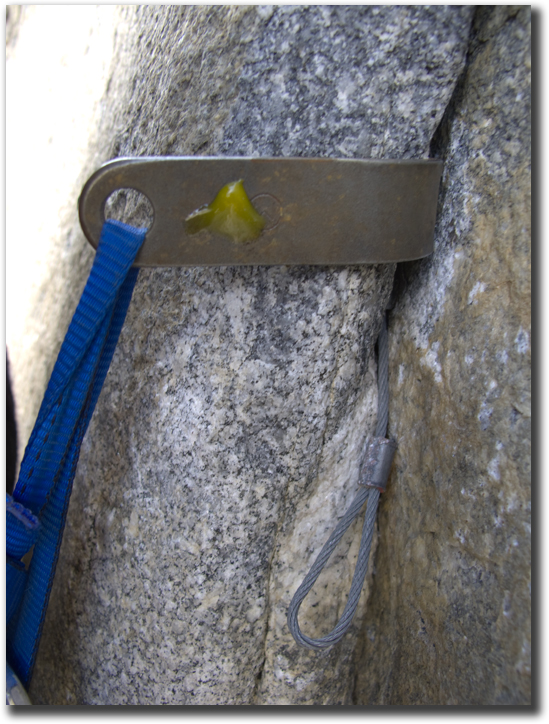
Visit on gorge.net
Yeah, a head in an A1 crack, that seems logical!
I started up on the 2nd pitch and right off placed a beak below a few fixed copperheads. I couldn’t avoid the heads so I clipped right up them, I was too excited being up on El Cap to worry about them much, the sky was crystal clear blue, the birds were flying around chirping and Horsetail Falls was crashing down a few hundred yards away. On a traverse right was an ugly set of heads smashed into a shallow crack that was easily avoided using a large Pika hook. I tired to take out the heads but broke my butter knife, ending my plan to remove every head I didn’t use.
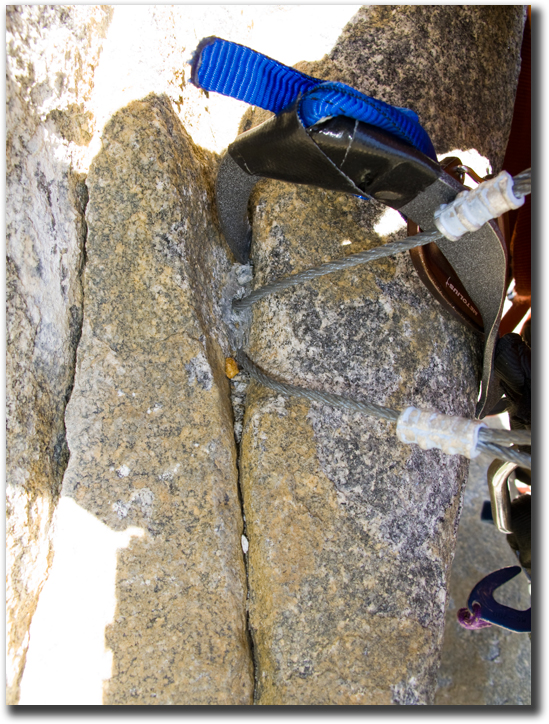
Visit on gorge.net
Can't we get even a bit more creative than this?
I was feeling in tune and climbed the 3rd pitch using no fixed gear at all, again using bomber nuts, cams and hooks right next to copperheads and pins.
My first solo bivy on ZM was as nice as all the rest the year before had been, the birds, the bats, Horsetail Falls, the crescent of moon, the activity down in the Valley. Earlier I had thought I’d take a book up on the route, figuring that I might have some quiet time to spend reading. Once I got my ledge set up and got comfortable, I spent all my time gawking at the sights, I was a tourist on El Cap and the sights and scenes fully captivated me.
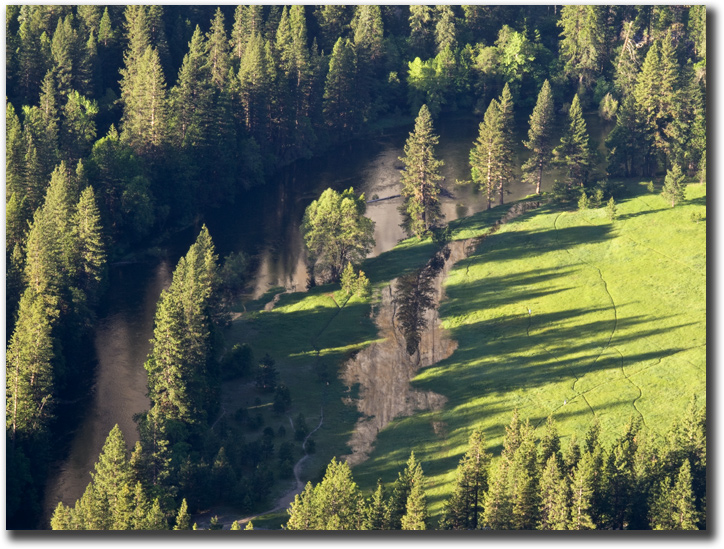
Visit on gorge.net
Beautiful morning views
The fourth pitch starts off a bit hard, a good cam right off the anchor but then it’s copperheads or beaks, five or six hook moves in a row and then a bad beak and head, this pitch set the tone for the rest of the route, top stepping off a hook (it was hard for me to tell if they were enhanced or merely well worn) to something questionable. I could understand why John freaked out here. He had very little experience placing pitons. Me on the other hand had learned to climb walls in the ‘70s and had placed thousands of pins and saw a placement right away. After the head, the pitch changes to C2 cams, an easy hook traverse and then some easy rubble climbing to the anchor.

Visit on gorge.net
starting the 4th pitch. (photo by Tom Evans)
An A3r hook pitch followed and since I was sure someone told me to go way right, I headed that way. I placed two cams under a large loose looking flake and proceeded up the face. Even top stepping, the hook placements were at the extent of my reach, at one point I had to thread a hook onto a wire nut to reach an edge. I couldn’t see the edge at all and tried not to think of the consequences of a fall. The hook held but it was on a flat edge that looked like it had never been used before, there were no hook scratches or divots anywhere near it. I top stepped again for another blind hook placement and started to get worried. All I had between the anchor, 30 feet below, and me were those two cams. More top stepping brought me to a flat, two-foot long, two-inch wide edge; I placed a hook on either end of it and distributed my weight between them while searching for more hooks above. Eventually I found none and calling up my Mark Hudon-ness (“You’re Mark Hudon and you’re Badass” from my Nose in a Day TR. (http://www.supertopo.com/tr/The-Nose-in-a-Day-10-09/t10498n.html));, I stood up on the edge and free climbed off it and up to the anchor. Later I read a ZM trip report from Matt Lambert where he writes that they climbed far to the left of where I was and that it was a “walk in the drilled hook park”.
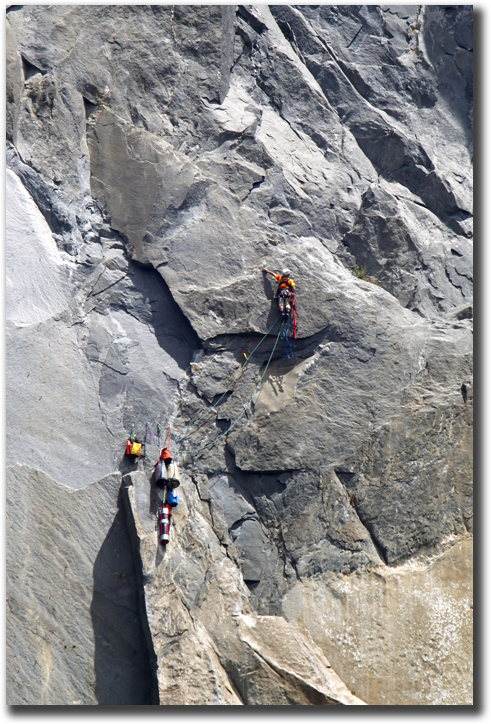
Visit on gorge.net
Going right was NOT the way to go. (photo by Tom Evans)
The pitches were short and each had a bit of free climbing in them so I was moving right along. I led a third pitch and set up camp below the Lightning Bolt Roofs. There was a five man Korean team on the Zodiac even with me off to the right and as I sat on my ledge, eating snacks, listening to music I watched them haul their half dozen bags and set up camp. They seemed to have some work hierarchy going on. I could see a couple of guys just standing on the ledges shooting the sh#t while another guy was busy unpacking the pigs, handing up food, sleeping bags, pads and water to everyone else. He got to sleep in a hammock suspended from each of the six ledge straps, everyone else got space on a ledge.
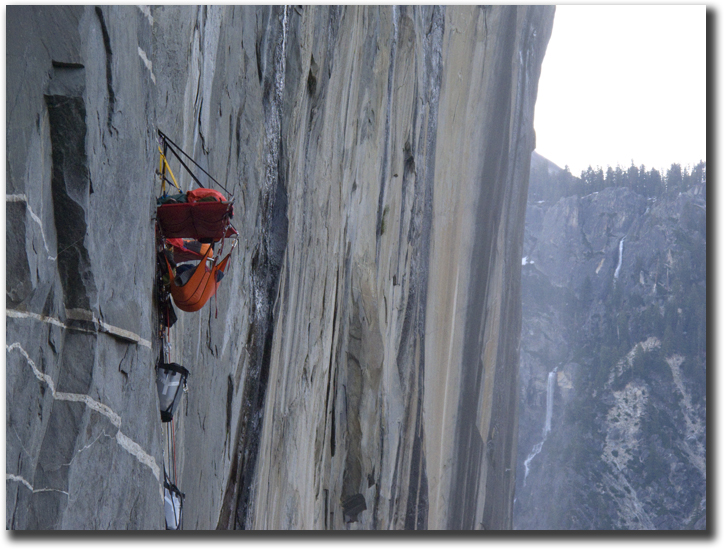
Visit on gorge.net
Tenement camping on the Zodiac
The next morning we yelled “good morning” back and forth and took photos of each other.
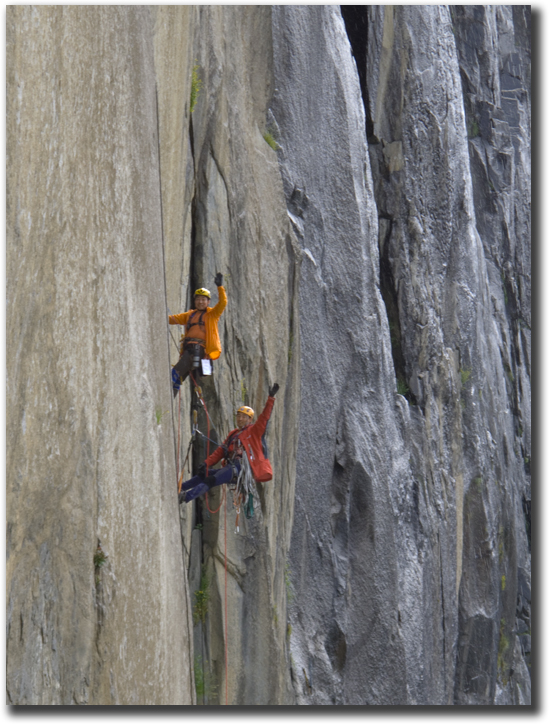
Visit on gorge.net
Good Morning!
Happily, I seemed to be in the soloing groove after only one day. For some reason, I am insanely confident in my abilities, probably illogically confident. Up to a point I feel that if something has been done then I can figure it out and do it also. I’ve never climbed with anyone who is a much better climber than me so I’m used to making all the decisions and leading all the hard pitches. I wanted to climb Zenyatta Mondatta, I didn’t have a partner and the one guy I could count on 100% was myself. I know how to solo a big wall so it wasn’t much of a stretch to decide to solo the route. I never though twice about the decision to solo it and never regretted it. I woke up, ate breakfast, drank coffee, took some photos and looked out at the beautiful Valley, it all feeling like how I start everyday of my life. Waking up on a portaledge seemed completely natural, normal and comfortable. So did packing it all away and getting in my aiders and starting to climb.
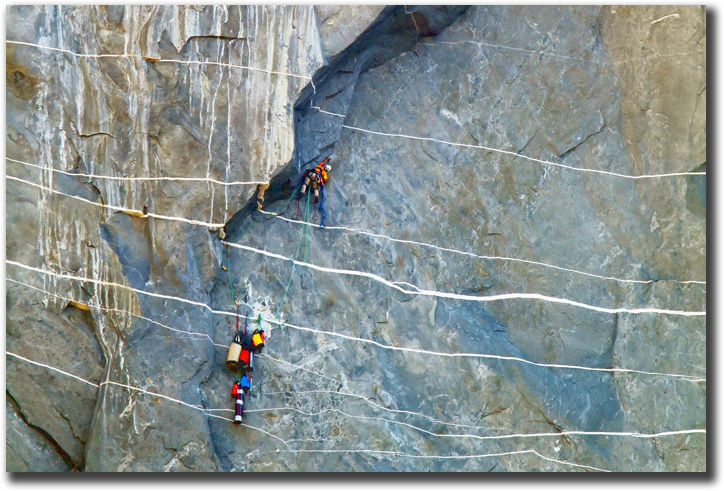
Visit on gorge.net
Starting the Lightning Bolt Roofs. (photo by Tom Evans)
I sort of talk to myself when I’m soloing, “ah, the Gray, the go-to cam”, “another Blue/Yellow, love you baby”, or I don’t talk or even think beyond what I need to do at that moment. I find the solo climbing quite a bit like meditation; my mind is on the one track of climbing and keeping safe. Of course I’m aware of where I am and the surrounding beauty, I’m aware of the beauty of simply being able to be up there. At the lip of the second Lightning Bolt Roof, probably the most exposed point on the route up to there I heard a call and commotion behind me. I turned to look and saw four of the five Koreans (all except the leader) looking at me from behind their cameras! I laughed and waved and took their photo as well.

Visit on gorge.net
My Korean buddies
I was expecting Zenyatta Mondatta to be the hardest of my current crop of El Cap routes and so far, it was not disappointing me. I’ve nailed old school A4 and maybe, maybe even a bit of A5 but to call me an “A4” climber would be overselling my ability a bit. Probably if it’s old school and it’s been around since the early 80s I could do it without sweating too many bullets. It wouldn’t be pretty but I’ve done enough aid that I’m sure I could keep it together to get up it. The ZM topo showed three A4 pitches but given that they’ve been climbed clean and that the route has been around for almost 30 years, I didn’t expect anything harder than what A3 used to feel like back in my day.
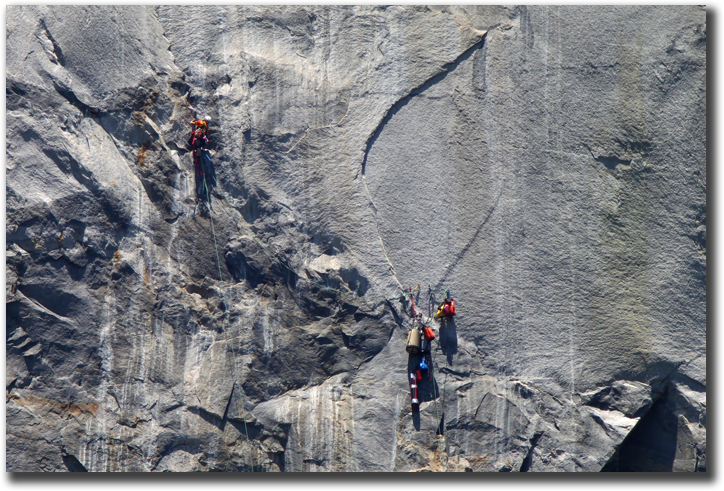
Visit on gorge.net
10 or 12 hook moves. (photo by Tom Evans)
The 10 or 12 hook moves right off the anchor of the 9 O’clock Roof pitch weren’t too very bad, some of them were quite bomber but still, it left me with no protection all the way back to the anchor. 10 or 12 hooks in a row sounds like certain death but, all in all, it wasn’t too bad. None of the hooks were too sketchy and most would have taken quite some effort to dislodge. I wasn’t worried too much about taking a 45 foot whipper onto the anchor since I could see that I was moving up towards a crack that I could get a good cam or two into. After that, I climbed onto a few rivets and a 3/8” bolt before actually getting to the roof.
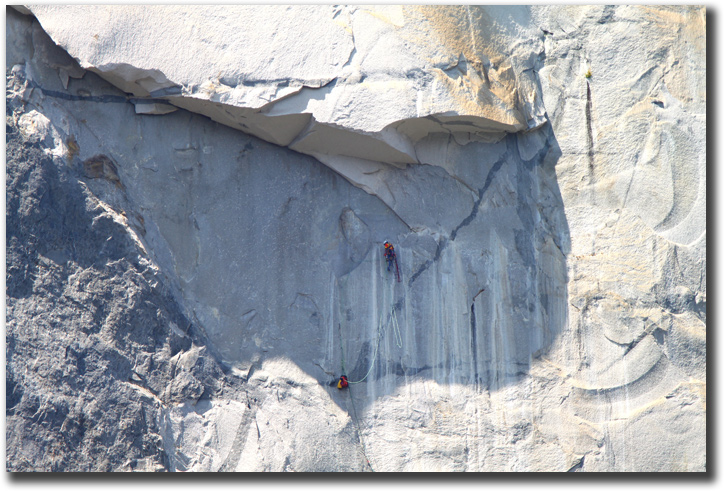
Visit on gorge.net
The loose flake is almost directly above me, hanging down a bit from the main roof. (photo by Tom Evans)
Once at the roof, I top stepped up and stuck a cam behind a flake, I weighted the cam a bit merely by grabbing its sling but when the flake flexed almost an inch I gave out a cry of “Oh my God”! and the rating of A4 took on a new, serious meaning. Memories of years ago, on the PO Wall, of a block falling on my finger, ripping out my fingernail and narrowly missing my ropes came rushing back to me. I moved down in my slings to recompose myself, took a few deep breaths, looked around at the beauty surrounding me, felt the air beneath my feet, felt the life in my lungs and then climbed back up, stretched out right and jammed a good cam far up into a solid looking crack and laughed at myself. Afterwards, a cam hook and a tiny, blindly placed nut led me to a few fixed pins. I jammed a small cam up behind a thin flake hanging down from the roof but as I was finding the gear for the next move, it pulled and I dropped down 25 feet, held by a fixed Lost Arrow driven straight up into the roof but sticking out more than half its length. I jumared back up and found a row of bat hook holes leading off right. While on a hook, moving onto a fixed pin, the pin pulled out when I had applied only half my weight to it. I saved myself on the hook but by now was getting pretty rattled. I was only 15 or so feet from the anchor and the end of the last pitch of the day. I could see better placements ahead so I sat there, recomposed myself again and moved on. All in all I climbed the pitch mostly clean, hammering only one or two beaks.

Visit on gorge.net
A ledge bed tightening tip.
The anchor was a mishmash of bolts, a few 5/16, one 3/8 with JB (Jim Bridwell on the First Ascent) stamped into the hanger and a few random quarter inchers, some with hangers and others without. Three of the bolts were clustered together due to hollow sounding flakes and one 5/16 was about four feet down from the main three. I reached far out right, set a hook and drilled a 3/8 bolt. The anchor is now nicely set up for haul bags on the left and portaledges on the right. I broke off the hangerless bolt, hammered it further into its hole with a punch and then filled the hole with grout. I pulled out the last quarter incher and found it to be a quite solid inch and a half bolt. I filled that hole as well.
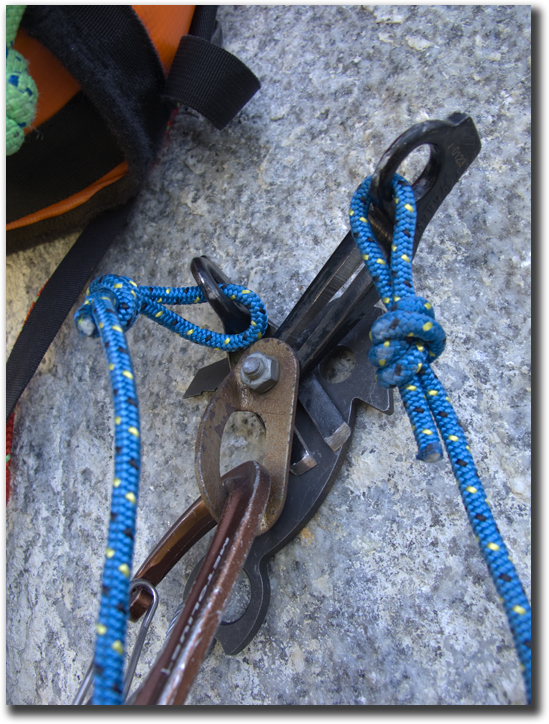
Visit on gorge.net
I needed the Beak to get some extra distance since the bolt was so long.
The next morning, looking at the topo, I could see that I was in for two days of A2 or A3 mornings and A4 afternoons. The 9 O’clock Roof pitch hadn’t really freaked me out but it did cause me to ratchet up my vigilance. My first pitch of the day started out with a nice A1 crack but soon veered right into an awkward flare. The anchor at the end of that pitch had a quarter inch bolt with its hanger flattened against the rock. My first thought was “why flatten the hanger and then leave it there, why not just leave it alone in the first place”? I used my tuning forks and pulled it out. It came out easily.
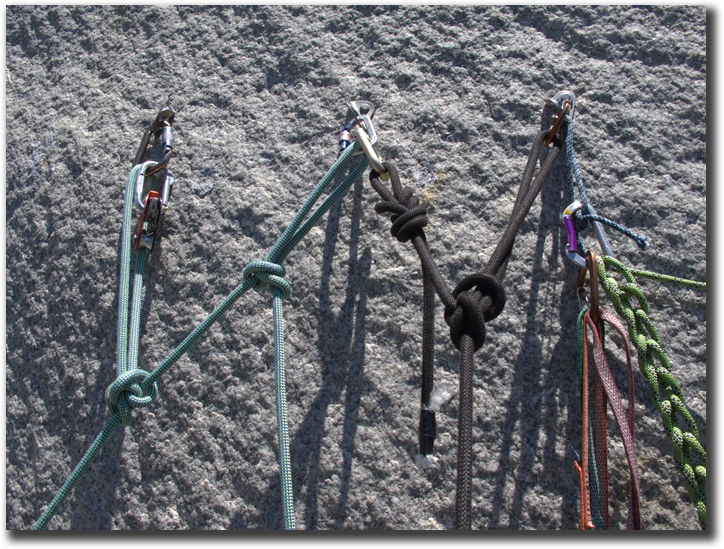
Visit on gorge.net
My technique for a big wall solo anchor.
My afternoon A4 pitch started out awkward but then moved out onto the face, wandering around to various flakes via hooks and heads. The final flake, laced with heads, looked like it might be A4 if it didn’t have fixed heads in it. If I had had a useable butter knife I may have been tempted to clean the fixed heads and place my own. Luckily, both my butter knives had broken earlier. At one point, I had clipped a fixed head and on second thought figured I ought to bounce test it. I bounced on it only twice before it pulled. It always freaks me out when a bounce test fails but I was sort of beyond caring. I clipped another of the many heads, bounced it and moved up. A few hooks led across a blank face, and true to Zenyatta Mondatta form, top stepping off a hook and reaching over a small roof was required to clip the anchor.
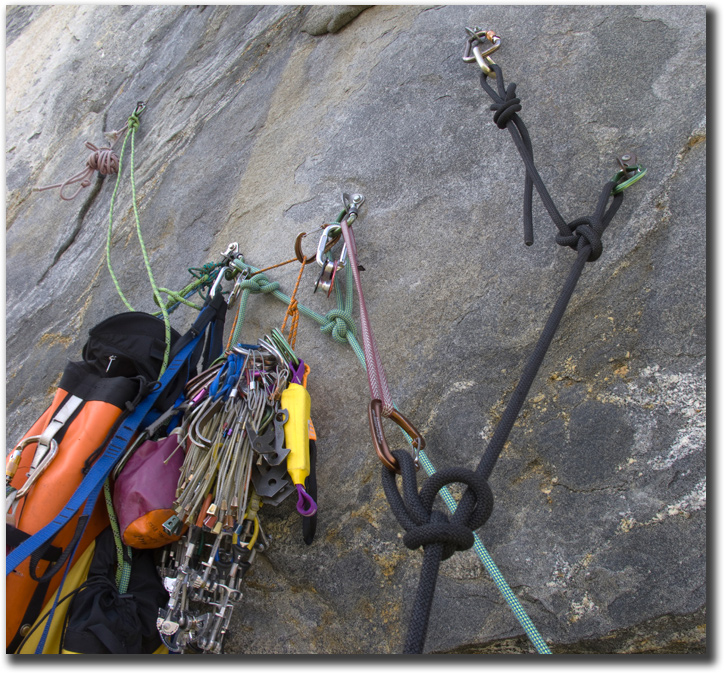
Visit on gorge.net
A mish-mash of bolts
This anchor was also a mishmash of various size bolts in odd places. I wanted to clean it up but it would have meant pulling three bolts and drilling two. I didn’t have the time and by now, the fourth day into the route, I wanted to take a rest day but couldn’t since Peggy and Ellen gave me 8 more days and I was already stretching my two-week trip out to three weeks.
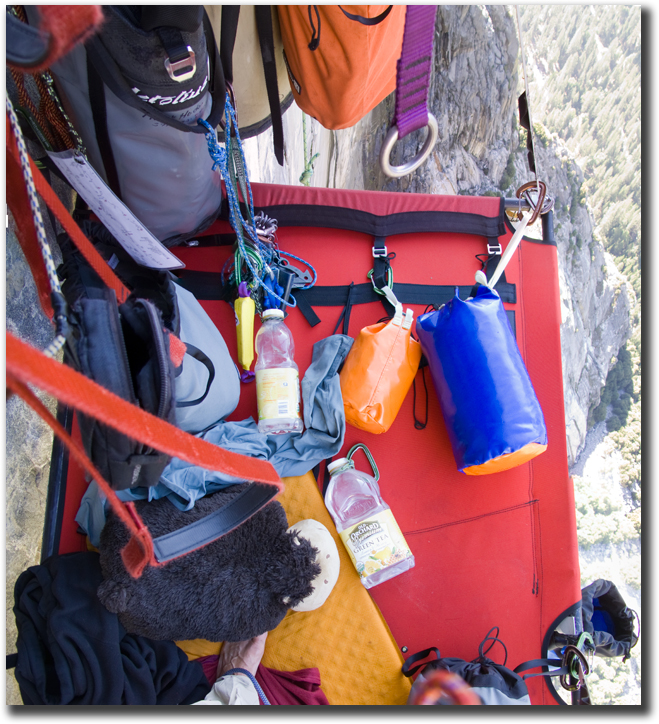
Visit on gorge.net
Your average, everyday ledge cluster.
My fifth morning began with the usual rivets, heads, hooks, hollow sounding rock and small nuts and cams. It seemed like business as usual and I laughed at myself when I stepped casually onto a hook or tiny nut that would have freaked me out before this route. I’d look up to find the route, only to see flakes, rivets, blank rock and shallow cracks, “Whatever” was the only feeling I could conjure up, “I’ll deal with it when I get there”.

Visit on gorge.net
Looks like something out of a horror movie, doesn't it?
I did almost start to cry once. Just once, then I recovered. I had moved off the anchor up onto the A4 pitch of the afternoon and had top stepped off a rivet to a hook that seemed like it had been used before. From that, I top stepped and placed a tiny nut in a sandy little hole. The view from the top steps of my aiders almost brought tears to my eyes. Holy Sh#t, I thought, what the hell do I do here! These flakes will be A10 to nail or copperhead! I’m gonna die! I stood there for 10 or 15 minutes praying that a bat hook would appear or I’d find a rivet behind a flake, something, anything so I didn’t have to start placing my own gear. I didn’t know what the hell I was going to do. I brushed the rock, looking for a hook edge, and noticed that it was rather flaky and dirty, I thought, “no one has ever been here before, I must be off route”. I looked right, high and low, and just as I looked left, I thought I heard a voice yell, “look left” and saw a rivet, fifteen feet to the side. I was glad I hadn’t dissolved into a crying fit as I down climbed off my top steps, jerked the nut out, reversed the hook move and reached over to the most beautiful rivet I’ve ever seen in my life.
The topo shows the actual A4 section above the site of my near breakdown but I don’t remember anything about it. That was the thing about Zenyatta Mondatta for me, there is no real A4 on it (maybe in one place if you removed all the fixed heads) but the route demanded a stepped up level of heads-up-ness, of “concern”. On one pitch, the topo showed A2 so I figured I wouldn’t need any hooks. Wrong! You need hooks on every pitch of ZM! They are not Wings of Steel level hooks but still, you need hooks and you need to be able to top step off them!

Visit on gorge.net
Why do haul bags hanging out in space look so cool?
The next day I had the unusual experience of looking straight down at a flying helicopter! Someone had fallen and had gotten hurt low down on the Zodiac. The helicopter flew in to drop off a ranger, then came back to pick up him and the climber in a litter. The idea of a rescue didn’t make me more vigilant but it did make me realize how little it would take for me to be in the need of a rescue myself, a small fall could easily twist an ankle or break a wrist. It was always a possibility but I tried not to think about it much. The start of the 13th pitch is rated A3r since the hard climbing is right above a slab. I wasn’t too worried but then I bounce tested a head and it pulled out. I looked up and figured I’d have to place my first head since my PO Wall attempt in 1978. I could see a spot were a large head might work but I didn’t have any on my rack and didn’t want to tag my bag up. I top stepped and tried to place a small head at the extent of my reach. It wasn’t going well so I decided to try a beak placement. I found a little crack and thought of John Salathe’s quote “where a blade of grass can come out, a piton can go in”. There was no grass but still, you get the idea, I was trying to generate some confidence. I hammered the beak till it started to buckle although it was in only a quarter of an inch or so. I bounce tested it, it held so I moved up. My next placement was a beak on top of a deadhead. It survived the bounce test and I moved up again. By now, I was worried about these two pieces pulling and hitting the slab. I reached high and slid a large beak into a scar and contemplated using it as a hand placed piece for about one tenth of a second. I gave it a few solid taps and happily moved up onto it. Further up, the topo showed an abandoned anchor. Only one of the bolts was needed for the climb so I took the other one out. Both were 1/4” bolts and the one came out easily.
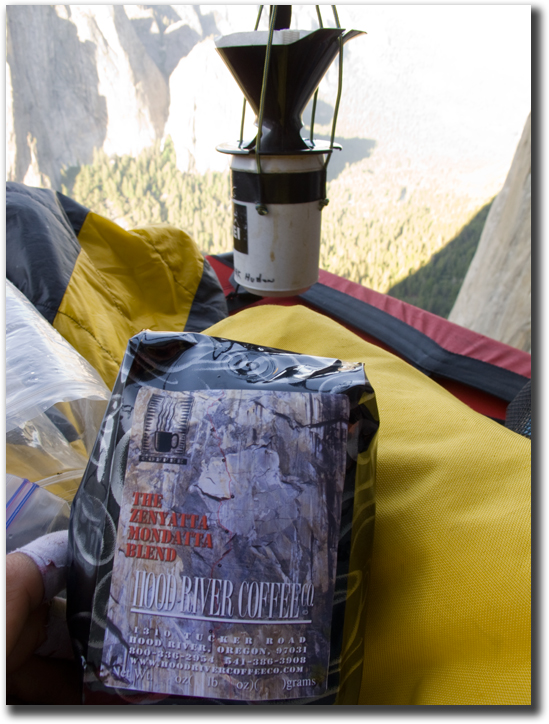
Visit on gorge.net
A special roast of coffee and special label made specially for me by, ME!
Moving off the anchor on the next pitch, the second to last pitch of the route, a cam pulled and I fell back onto my haul bags. I was sort of freaked that two seemingly good cams had pulled out on me when I realized that both of them had sticky cams. I figured out that one set of cams was not expanding to fill the crack and as I weighted them the axle had shifted and the cams pulled. The pitch wanders but when you’re soloing, the rope stays static across the rock and does not run through your gear so you never have to worry about drag. Since the pitch wandered quite a bit I cleaned a fair amount of it on my way down the haul line.
I was one pitch from the top but I was in no hurry to get there. I knew that climbing that one pitch, cleaning and hauling and getting all my gear safely away from the edge could easily take me all day.
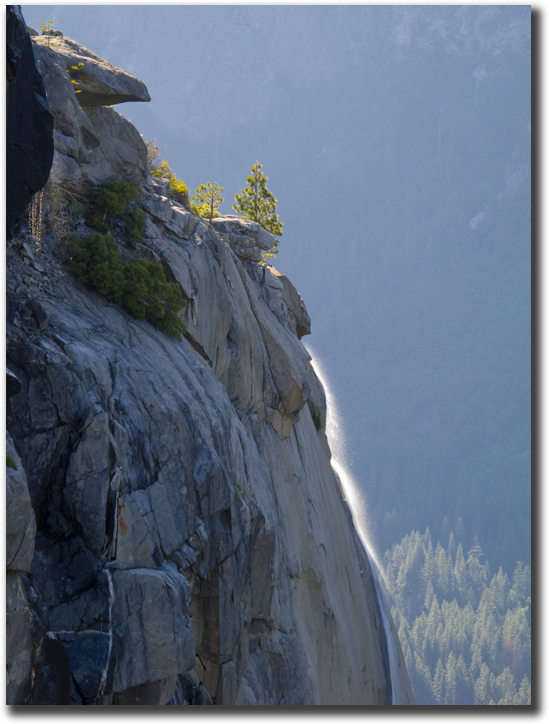
Visit on gorge.net
The top of Horsetail Falls.
During the night, I felt a small animal walk across me and over to my food bag, I woke to see a wall rat in the crook of my lower leg and foot. Before I could think I snapped my leg straight and launched the rat off my ledge. It took me a minute or two to realize what I had done and that I had in fact launched it. “Oh, well”, I though, “life is tough if you’re a wall rat” not really thinking about how that statement might apply to me, and went back to sleep.
Never let your guard down when you’re on ZM. Take it from me. Nothing bad happened on that last pitch but I did have to keep thinking and watching out for mistakes. I set up the last anchor and then climbed to the top with no protection on the remainder of the lead rope. I left all the gear I had on top, wrapped the tree with my tag line as an anchor and then rapped down to the intermediate anchor and ferried up my tag bag and some more gear. It always feels funny to be on the top of El Cap, safe and sound, you can walk around unroped, drop stuff, only to clip back into the rope and go back over the edge. Down I went to the lower anchor, I released the haul bags, lowered them out, took one last look down the route, and started to jug, telling myself, “it ain’t over till every last bit of gear is on top and safely away from the edge”.

Visit on gorge.net
More ugly and useless heads on the last pitch.
Three hours later, everything was on top and away from the edge. My gear was scattered all over the place but I had nothing to do and the rest of the day to do it.
I‘m pretty happy with my ascent of ZM. I hadn’t planned to solo it so hadn’t spent any time psyching up for it. The opportunity had arisen that I could solo it and I went and did it. I had also left the route in far better condition than I had found it in. I removed 16-20 useless copperheads, removed four useless bolts and had made one anchor more comfortable. I had cleaned off every piece of tat on the whole route that I didn’t use (I used only 3 or 4) removed a few pieces of broken pitons and another couple of unusable fixed beaks. On top I had done a general clean up of the area, picking up a few handfuls of small debris and hiked down four abandoned water bottles.
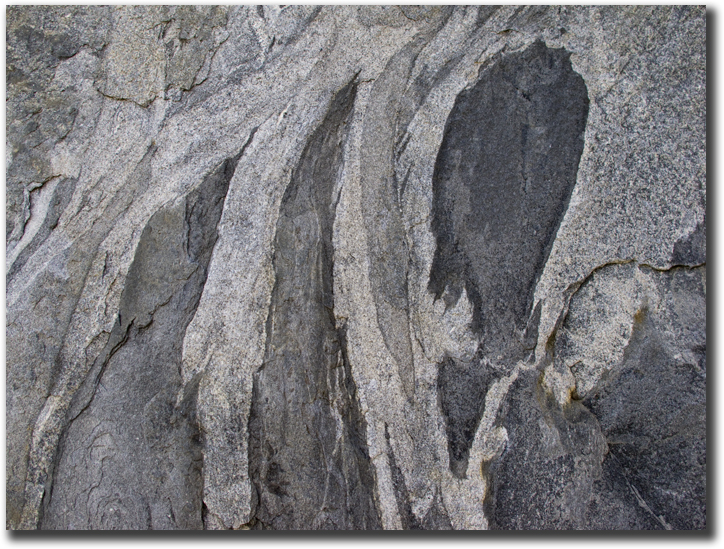
Visit on gorge.net
El Cap's art
This was my third aid route on El Cap in the last two years and I’m happy to find that I’m still learning things about climbing big walls. I have a better idea about what I want to do with fixed heads (remove them all, place the ones I need on the lead and then remove even those) and how cleanly I can climb most pitches (take half of the recommended pin rack and expect to use none of it aside from Beaks). I hammered less than 15 pieces on ZM and all of those were beaks.
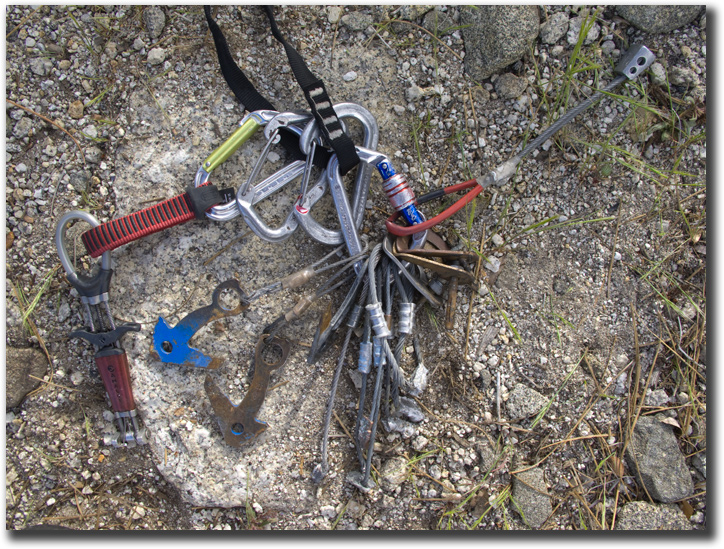
Visit on gorge.net
Slag gear
The top of El Cap is the most beautiful place in all of Yosemite, in my humble opinion, the perfect place to end a great adventure. This climb had been a bit less emotional for me than my first solo, it felt a bit more matter of fact, but my feelings upon reaching the top were the same. I was incredibly thankful to Peggy and Ellen for giving me the extra time I need to solo the route and I was incredibly thankful to simply be able to do it.
I found a comfortable rock facing the Valley and Half Dome and meditated for a half hour or so. With my eyes closed and my body relaxed I could feel the breeze on my face, I could feel my fingertips pulsing along with my heart. Even with my eyes closed the colors of the beautiful scene before me seemed to dance and meld into scenes from the wall. The air was cool in my lungs and I got a sense that it all fit, it all worked, it was all so right.
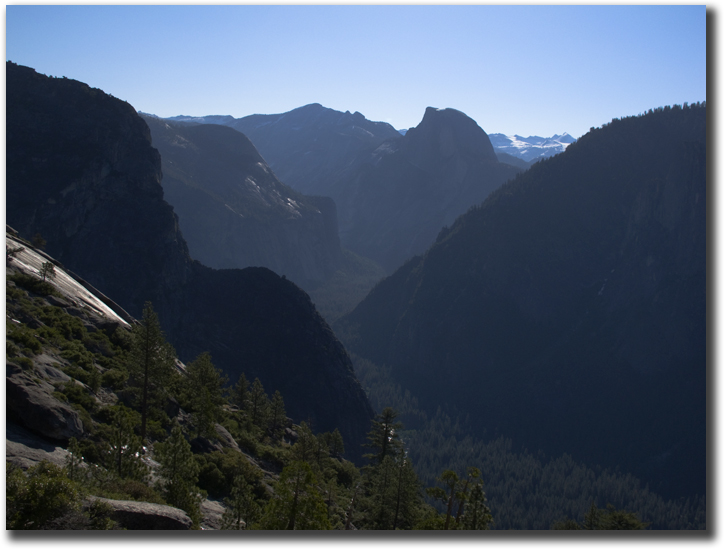
Visit on gorge.net
The Incomparable Valley
